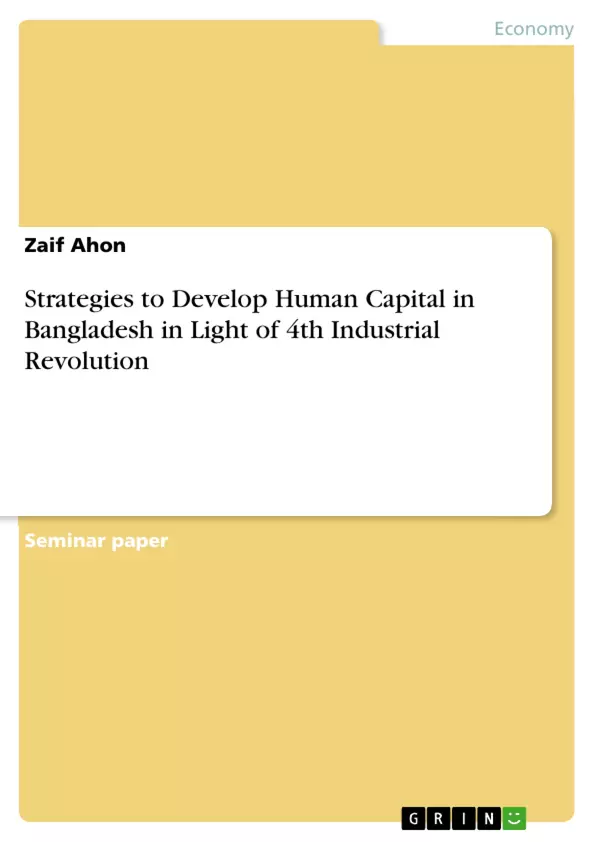As the fourth industrial revolution blurs the physical and digital divide, its impact shall be perceived upon all levels of socio-economic, industrial, governmental and individual dimensions. In the context of ASEAN countries, the greatest threat to employment comes in the form of automation that will make the human resource redundant and replaceable particularly in China and Bangladesh: two of the leading manufacturing countries in the world. If we look at the current scenario, it can be obvious for us to deduce that Bangladesh is not taking much of an initiative towards the fourth industrial revolution. But there are plenty of ways the fourth industrial revolution can be utilized to develop human capital.
Human capital development starts from as early as the childhood phase of the people as it represents skills, knowledge, and health that people accumulate over their lives. Encouraging livestock production will be helpful for child growth due to the increase in dairy production. Rather than a siloed approach, multisectoral coordination while taking initiatives, in nutrition interventions is effective. Family planning programs that enable birth spacing reduce demands on the low maternal nutrient stores in developing countries. We also should focus to collaborate with programs such as Jhilmili, Proshikkha, Brac Development Programs, UNICEF.
While taking a look at the actual situation regarding education and unemployment, one finds a rather paradoxical relationship. Higher levels of education are associated with lower levels of unemployment in developed countries, but not so in developing countries. By introducing automation technologies, the yield of agriculture sector can be increased, this will ensure two things together, it will attract the technologically proficient people and make the sector lucrative enough towards being able to compete with lucrative jobs. We should also look to introduce vocational and technical education early in junior secondary school to encourage attaining dual qualification.
For training development activities certification of skill or Apprenticeship (Dual Training System) has to be promoted). Besides, Branding strategies should be deviced specifically catered to the Labor Capital with campaigns like "We don't build beams; we build dreams."
Inhaltsverzeichnis (Table of Contents)
- Introduction
- Background
- Objectives
- Specific Objective
- Broad Objectives
- Human Capital Development in Bangladesh
- Risks
- Human capital development: Facing Industrialization 4.0.
- Impact on the flow of work (instructional design vs learning design)
- Bangladesh's stand on the Map of fourth Industrial Revolution
- Human Capital Development Strategies
- Early Childhood Phase
- A Focus on the Right Kind of Education
- Training Development Activities
- Branding Human Capital
- Conclusion
Zielsetzung und Themenschwerpunkte (Objectives and Key Themes)
This strategic paper aims to examine how skills can be acquired and deployed throughout the working life and formative years in Bangladesh, particularly in the context of the Fourth Industrial Revolution. It explores strategies to develop human capital and address the skill gap, focusing on the role of education, training, and other factors crucial to developing a strong future workforce.
- Human capital development in Bangladesh and its impact on the workforce
- The implications of the Fourth Industrial Revolution on human capital management and development
- Strategies for developing human capital in the early childhood phase
- The importance of education and training in preparing the workforce for future challenges
- Branding and promoting the human capital of Bangladesh in the international market
Zusammenfassung der Kapitel (Chapter Summaries)
- Introduction: This chapter sets the stage by highlighting the importance of human capital development in the face of the emerging Fourth Industrial Revolution and the need to bridge the skill gap. It emphasizes the role of education, training, and other factors in creating a strong future workforce.
- Background: This chapter provides context by discussing the role of the Ministry of Labor and Employment in Bangladesh, highlighting the significance of overseas migration and its contribution to the economy. The chapter also addresses the issue of the skill gap and its impact on human capital development.
- Objectives: This chapter outlines the specific and broad objectives of the paper. Specific objectives include identifying demanding job sectors in the international market, determining skill trade attributes, and identifying areas for improvement in human capital development. Broad objectives encompass analyzing comparative advantages of labor supplying countries, exploring the impact of the Fourth Industrial Revolution, and addressing stunting in early childhood.
- Human Capital Development in Bangladesh: This chapter explores the challenges and opportunities related to human capital development in Bangladesh, considering factors like task-specific human capital and the need to bridge the skill gap.
- Risks: This chapter focuses on the potential risks and challenges associated with human capital development in Bangladesh, particularly in the context of the Fourth Industrial Revolution. It discusses the implications of automation and the need for effective strategies to address these challenges.
- Human capital development: Facing Industrialization 4.0.: This chapter explores the impact of the Fourth Industrial Revolution on human capital development, focusing on the changing nature of work, the need for new skills, and Bangladesh's position in the global context.
- Human Capital Development Strategies: This chapter examines various strategies for developing human capital in Bangladesh, including initiatives for early childhood development, education reform, and training programs. It also explores the importance of promoting entrepreneurship and branding the Bangladeshi workforce.
- Branding Human Capital: This chapter focuses on the need to develop effective branding strategies to promote the human capital of Bangladesh in the international market. It suggests ways to highlight the skills and talents of Bangladeshi workers and attract potential employers.
Schlüsselwörter (Keywords)
Key terms and topics of the paper include human capital development, Fourth Industrial Revolution, skill gap, overseas migration, education, training, early childhood development, automation, branding, and government policies. It also emphasizes the importance of developing a future-ready workforce, bridging the skills gap, and promoting inclusive economic growth in Bangladesh.
- Arbeit zitieren
- Zaif Ahon (Autor:in), 2018, Strategies to Develop Human Capital in Bangladesh in Light of 4th Industrial Revolution, München, GRIN Verlag, https://www.grin.com/document/469584



